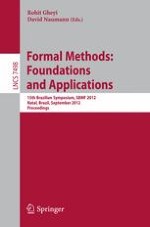This book constitutes the refereed proceedings of the 15th Brazilian Symposium on Formal Methods, SBMF 2012, held in Natal, Brazil, in September 2012; co-located with CBSoft 2012, the Third Brazilian Conference on Software: Theory and Practice. The 14 revised full papers presented together with 2 keynotes were carefully reviewed and selected from 29 submissions. The papers presented cover a broad range of foundational and methodological issues in formal methods for the design and analysis of software and hardware systems as well as applications in various domains.
